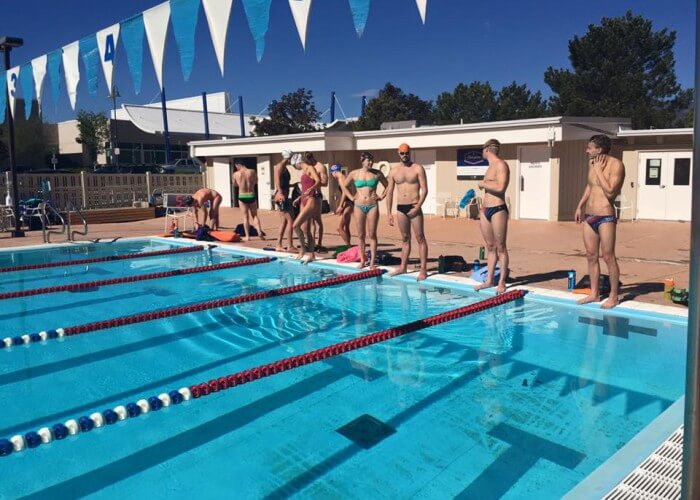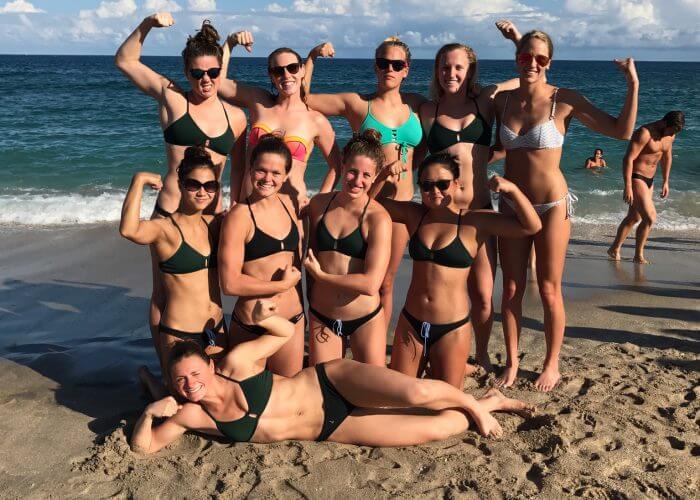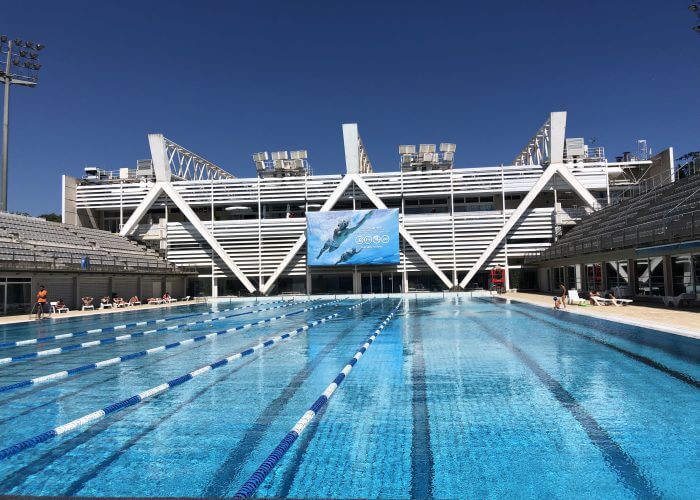Adding Variety to a Swimmer’s Training

By Ashleigh Scott, Swimming World College Intern.
Every swimmer goes through times of feeling as though practices are redundant and stale. Walking across the pool deck day after day, jumping into the same water sometimes twice a day can get boring. However, there seems to be some type of magical science behind putting swimmers in a different environment that alters their motivation and eagerness to swim. Something about adding variety to a swimmer’s training makes all the difference.
A training camp in a southern environment may be the ticket for those trapped in the grey cold of the north. Practicing in a championship pool before a swim meet or incorporating different equipment and drills into workouts may lead to the “lightbulb” moment. These are all different ways to make practices seem a little less repetitive and a lot more exciting, ultimately adding in more variety to a swimmer’s training. Change really does go a long way, especially when high yardage is involved.
Let’s take a look at these different ways to improve the groove at practice.
Variety in Location

US Olympic Training Center altitude open water camp 2015. Photo Courtesy: Tyler Fenwick.
Different teams all over the world take part in training camps. The purpose of training camps is to intensify workouts for a certain amount of time before entering taper mode for an important meet. Typically, teams go to warmer climates to enjoy some sunshine and great outdoor training facilities. They do this all while accomplishing the goal at stake: getting faster.
However, while this may sound totally great, the whole training twice a day for two hours bit is exhausting. Training camps are meant for higher volume practices and possibly increasing the number of workouts per day. Needless to say, swimmers can expect challenging sets and tough intervals – no different than training at home. The main difference is a mindset change that accompanies location change. Often, training camp provides an environment that resembles an adult summer camp in terms of not having to worry about the outside world for a week or two.
Sun’s out, Guns Out

William and Mary women on training trip 2016. Photo Courtesy: Lauren Freeman
Swimming in the same pool day after day can become boring, and swimmers may feel less inclined to attack a practice with enthusiasm than they would if they were somewhere fresh. Southern climates are great for training camps because sunshine naturally makes everyone happy. Girls can wear training bikinis, the smell of sunscreen becomes an exhilarating scent, and cap and goggle tans don’t even bother anyone, because they’re the result of being outside in the heat.
Sunshine makes everyone smile, and therefore makes the practice vibes enjoyable, leading to a happy coach, too. What more could a swimmer want? Training camps embrace new scenery and encourage top-notch training amongst all athletes. When a swimmer hears “training camp,” the sunscreen sales in the middle of the winter skyrocket, and the excitement begins. According to BYU researchers, “…days with plenty of sunshine were associated with better mental health — in fact, the availability of sunshine has more impact on mood than rainfall, temperature, or any other environmental factor.” So, there really is a science behind sunshine and happiness!
The change in location also forces swimmers to change their typical weekly meal planning. You know your kitchen like the back of your hand, and cooking meals in that same space everyday can become bland. However, on training trip, group meals are something to look forward to. Recipes are shared, and it’s much more fun to eat together than by yourself. All in all, swimming somewhere with a sunny climate is a great way to add some spice to repetitive training.
Diverse Competition Pools

Photo Courtesy: Taylor Brien. Championship Competition Facility
Have you ever swum at a pool that leaves you awe-struck? You catch a feeling that makes you want to go back to the exact lane you raced in and swim the event all over again.
That feeling is a rare yet motivating one. It can happen at any pool, but specifically swimmers find themselves feeling this way when they have swum at a notable or famous pool. Swimming at a facility where Olympic Games were once held, or at a pool of a current record-holding Olympian. Or, perhaps you are swimming at a top-notch facility where a big college swimming championship is being hosted. Whatever the case may be, there are a multitude of pools that can remind swimmers of why they fell in love with the sport all over again.
Changing to Somewhere Notable is Exciting

1992 Barcelona Olympic pool. Photo Courtesy: Kate Walter
There is a sense of pride and disbelief that strike swimmers when they find themselves in one of these mentioned locations. They dive into the pool, warmup for the meet and feel as though every other practice they have done has floated away. It’s just them and the current pool, in all the beauty it offers. The extra frigid water is not even a bother. After all, this is the pool where the 1992 Olympics were held. Champions of our sport once swam in this exact lane. Of course nothing else matters.
Swimming in beautiful and historic facilities truly helps swimmers better understand why they have stuck with the sport for as long as they have. While completing practice after practice in the same pool can get boring, a practice in a historically signifiant location may be the boost you need to buckle down and swim with purpose.
Different Equipment and Drills

Photo Courtesy: FINIS drill of the week. Different drill for breaststroke.
While location encourages variety in a swimmer’s training, another factor to change is training equipment. Adding in new equipment and drills are great ways to add variety to a swimmer’s training, and steer away from the status-quo. When coaches command their swimmers to use fins for one round of the set, the athletes feel as though they have won the lottery. The “F” word really can turn a swimmer’s practice around.
Fins are a commonly used piece of equipment for all swimmers; however, different types of equipment such as parachutes and bands can also be great tools during practice. Not only do they help work different aspects of the strokes, but they also certainly make for a more varied practice than just lap after lap of freestyle.
Finally, there are different videos surfacing on the internet of coaches tying in unique drills into practices to mix things up. While there are the classic “six-kick switch” drills, those do not have to be the only ones! For example, put a paddle on your forehead while swimming backstroke to learn balance. Or, have a coach blow a whistle indicating when to start kicking faster for a period of time. These are both great drills that provide change within the practice but keep the intensity of the workout.
Spruce up practice by adding in some new drills and equipment! US Masters Swimming writer and Certified Level 3 coach Terry Heggy writes a great article about different drills to spice up a practice. Click here to access the story!
So What?
At the end of the day, swimming is a grind. Swimmers may find themselves sick of the routine nature of their sport. However, there are ways to rediscover that eagerness and excitement to train despite these feelings. “Staring at the black line on the bottom of the pool can get a little monotonous sometimes. Something I love that keeps me engaged is having music at practice. Music is great for keeping positive vibes and high energy,” suggests Boston College Swimming alum Maria Abrams.
So, find a way to train in a new or sunny place. Research nearby pools that have historical significance. Take initiative to do your own research to find great drills. Your coach might even incorporate them into practice! Adding new training techniques fight the monotony to freshen up your training.
What are some other ways to add variety into your training?
-All commentaries are the opinion of the author and do not necessarily reflect the views of Swimming World Magazine nor its staff.



